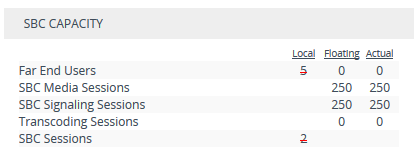Floating License Model
The Floating License is a network-wide SBC capacity-related license pool, which is managed by AudioCodes OVOC and the cloud-based License Manager, and shared dynamically among multiple devices. The Floating License is a pay-as-you-grow service, eliminating the need to manually purchase additional SBC licenses each time your capacity requirements increase. You initially purchase a Floating License based on your estimated SBC capacity requirements. If you later experience business growth and your devices use more SBC licenses than specified by the Floating License, you are billed for these additional licenses. In other words, the Floating License pool capacity can be exceeded.
The Floating License pool includes the following SBC capacity license types:
|
■
|
SBC sessions (maximum number of concurrent SBC call sessions - media and signaling) |
|
■
|
User registrations (maximum number of SIP endpoints that can be registered with the device) |
As an example of how the Floating License pool operates, assume that an OVOC tenant is allocated 500 SBC Session licenses and the tenant has deployed three devices (A, B, and C), where each device has a maximum capacity of 250 SBC sessions. If A and B are operating at maximum capacity (i.e. the aggregated number of active SBC call sessions is 500), and then C requires 50 SBC sessions, even though the initially purchased Floating License pool capacity has been reached (500), C is allowed to process these 50 new call sessions. When you are next billed, you are charged for these extra 50 SBC session licenses.
For providing the Floating License service, OVOC and the Cloud License Manager need to be set up accordingly (refer to the OVOC User's Manual). The Floating License service also needs to be enabled on these devices. Once these devices connect to OVOC, they are "open" to use any number of licenses in the Floating License pool. However, capacity is limited by the device's inherent maximum capacity support and by an optional user-defined limit called Allocation Profile (discussed later in this section), which specifies a capacity that is less than the device's inherent capacity per SBC license type.
Connection between the devices and OVOC is established over SNMP. Functionality of the Floating License service is managed over TCP/HTTPS REST. For more information, see the One Voice Operations Center IOM Manual and the OVOC
Security Guidelines. Connectivity status with OVOC is displayed in the 'License Server Status' field on the License Key page (see Viewing the License Key). If the device loses connectivity with OVOC, it continues using the licenses that it received before the disconnection for a specific grace period, and then once this period expires, it stops accepting new calls.
The devices report their SBC license consumption per license type to OVOC at fixed intervals (typically, every five minutes). OVOC accumulates these reports and sends them to AudioCodes Cloud License Manager every 12 hours with all the SBC licenses usage in the last 12 hours. OVOC uses REST APIs over HTTPS to report to the Cloud License Manager. AudioCodes personnel analyze these license consumption reports in the Cloud License Manager on a monthly basis to check if capacity specified by your Floating License was exceeded. If it was exceeded, AudioCodes sends you a report detailing the excess licenses and requests that you purchase additional SBC licenses for your Floating License. To view the Floating License reports of SBC license consumption that the device sends OVOC, see Viewing Floating License Reports.
When the device uses the Floating License, the License Key page (see Viewing the License Key) displays "Floating License" in the 'Mode' field and display the SBC capacity licenses received from the Floating License under the SBC Capacity group, as shown in the example below:

|
■
|
'Local': This column displays the number of SBC licenses per license type from the locally installed License Key. These licenses are not used by the device and the figures are displayed crossed out (strikethrough). |
|
■
|
'Floating': This column displays the number of SBC licenses per license type received from the OVOC Floating License pool. |
|
■
|
'Actual': (see the 'Floating' column). |
The device sends the following SNMP alarms to indicate various conditions relating to the allocation of SBC licenses by the OVOC Floating License pool:
|
■
|
acFloatingLicenseAlarm: Sent if you have configured an Allocation Profile that exceeds the device's maximum supported capacity. |
|
■
|
acCloudLicenseManagerAlarm: Sent upon various conditions such as loss of connectivity between the device and OVOC. |
For more information on these alarms, refer to the device's SNMP Reference Guide.
|
●
|
The Floating License only provides SBC capacity licenses (listed previously). Therefore, your device must still be installed with a local License Key to enable the other ordered license-based features (e.g., Test Calls) and capacity. |
|
●
|
For configuring the Floating License on OVOC, refer to the OVOC User's Manual. |
|
●
|
The Floating License cannot operate with other OVOC-managed SBC capacity license modes (e.g., Fixed License). Therefore, before enabling the Floating License, make sure that the other license modes are disabled on OVOC. |
|
●
|
The Floating License ignores OVR,, and LAD capacity licenses in the local License Key. |
